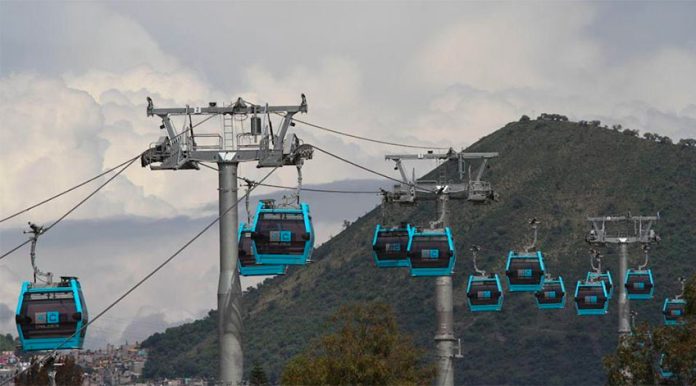The new cable car in the north of Mexico City has proved a hit with residents who are using the airborne transportation method far more than was predicted.
Line 1 of the Cablebús system, which went into full operation on June 11, has registered 56,000 users per day compared to the 48,000 predicted. That makes it the second most used cable car in Latin America, even by pre-pandemic numbers, according to city officials.
The 2.9-billion-peso line (about US $145 million) links Cuautepec, a working-class neighborhood in a hilly area of the Gustavo A. Madero borough, to the Indios Verdes Metro and bus station, taking 33 minutes end-to-end. It is the longest cable car line in Latin America at 9.2 kilometers, with six stations along 63 towers. It travels at five meters per second, or 18 kilometers per hour.
The new transit option has seen robust uptake, despite social distancing measures which only allow six people to travel in each cabin, leaving four seats empty.
Almost 10% of passengers so far have benefited from free transport through the the Inclusive Metro Pass for people with disabilities and seniors over 60.
The first section running between Tlalpexco and Campos Revolución stations at the Cuautepec end of the line first opened on March 4. At the time, Mayor Claudia Sheinbaum highlighted the social benefit the cable car would generate. “It’s a historic day because we’re opening a new system of collective transport … it’s social transport … Having the best transportation for the poorest parts of the city reduces inequality,” she said.
The mayor added that a second cable car line is under construction in Iztapalapa, a sprawling, densely populated borough in the capital’s east.
Previous to the opening of Line 1, Guillermo Calderón, director of the electrical transportation system in Mexico City, said that residents in Gustavo A. Madero had long been deprived of adequate transport links. “They [currently] make their trips [to the Metro station] in small vans that descend through narrow streets, and that may take, from the highest point [of the area] … as long as 55 minutes or an hour,” he said.
The Associated Press reported that traditional transportation solutions like bus or subway lines are almost impossible in the area because there are no rights of way in the densely packed slums, which are crowded along hillsides on steep 15-degree slopes.
A public transit cable car system already operates in Ecatepec, a México state municipality that borders Gustavo A. Madero. The most used cable car in Latin America is the Purple Line in La Paz, Bolivia, which transported 58,000 people per day prior to the pandemic. In third place is the Yellow Line in the same South American city, which transports 45,000 passengers per day. Medellín in Colombia and Río de Janeiro in Brazil also have similar cable car systems.
A journey on Line 1 costs 6 pesos. It runs from 5:30 a.m. to 12:30 a.m. Monday to Friday; 6:00 a.m. to 11:00 p.m on Saturdays; and from 7 a.m. to 11:00 p.m. on Sundays.
Mexico News Daily
